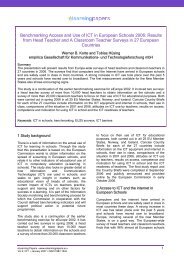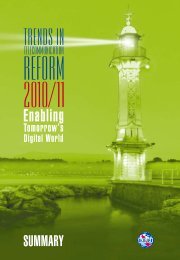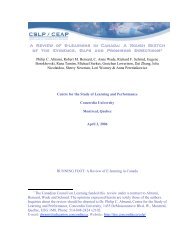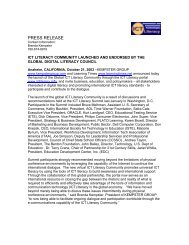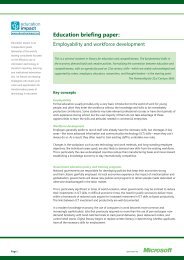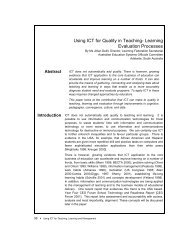147 pages pdf - ICT Digital Literacy
147 pages pdf - ICT Digital Literacy
147 pages pdf - ICT Digital Literacy
Create successful ePaper yourself
Turn your PDF publications into a flip-book with our unique Google optimized e-Paper software.
Pedagogy & Webagogy -- Ready, Set … TRAIN and FACILITATE!<br />
#582: Eleven Tips For The Price Of One<br />
Log on/call in early. This allows time to relax before the presentation and to handle any unanticipated<br />
"surprises."; Prior to beginning, take a deep breath, relax, and be as conversational as possible in your<br />
delivery; Be very familiar with the content. Practice several times so you know how much time it takes to<br />
present it. This will help you relax and not be overly worried about the time; Factor in the time allotted for<br />
audience interactions. Most presentations have a Q&A session and some have other audience interactions<br />
like polling. Remember to include time for these in your total presentation timing; Consider having "pad<br />
questions." These help to "get the ball rolling" in case your audience is shy or slow to begin participating in the<br />
Q&A session; Avoid "dead air." If audience feedback is being taken via polls, consider elaborating on the<br />
reason for asking the questions and/or the value of their responses to avoid this; Have a clock or watch<br />
handy. Occasionally check it to pace your timing; Try to eliminate interruptions. Put a "Do Not Disturb" sign<br />
on your closed office door and turn off your cell phone and/or pager; Try to minimize ambient noise.<br />
Coughing, throat-clearing, and paper shuffling can often be reduced simply by awareness; Be polite. If copresenting<br />
with others, do not click on slide titles while someone else is presenting. All presenters have equal<br />
control of slide publishes during an event; Keep it in perspective. If you make a mistake or lose your place, it's<br />
not the end of the world. Don't make more out of it than necessary by over-apologizing or sounding defeated.<br />
The less attention you draw to a mistake, the quicker your audience will forget it.<br />
Bryan Crum<br />
Communicast, Inc.<br />
#583: Help Students And Yourself By Listing Expectations<br />
Let students know the timeframe they can expect a response from you. Before I instituted the ("within 48<br />
hours") time frame, I would receive several daily emails asking me if I had received an email or assignment<br />
yet. Since I've identified this time frame and abide by it, those "did you get it " emails have stopped. And<br />
the guideline: "Should you have questions, please post them in the appropriate discussion thread" has also<br />
saved me a lot of spent answering the same questions. Now, I only accept emails regarding personal<br />
issues (grades, requests for extensions, etc.). I find that not only do I save time and energy, but many<br />
times the students will help each other within that discussion area.<br />
Diana Voss<br />
Stony Brook University<br />
#584: Teach Out Of The Box<br />
Engage the mind of every participant every 3-5 minutes. Think beyond the tools and technology<br />
to other options such as participants spending 10 minutes writing in their materials during a<br />
web-cast. Use the tools in different ways, such as asking a multiple choice question with no<br />
single correct answer, and having participants explain their choices.<br />
Ken Seemann<br />
Nextel Communications<br />
#585: Set Both The Learner Expectations And Yours Up Front<br />
Complete a run-through, especially if it is your first time teaching - you will get a better idea of the flow as well as<br />
the time needed and have practice using the technical equipment. Test the day before and then an hour before<br />
the session so that you are prepared. Have a "Plan B" for any technical problems you may have.<br />
Katie Amato<br />
Progressive<br />
#586: Keeping The Learner's Attention<br />
How can you do this and be successful? Consider using action learning where learning is directly related to<br />
personal values, goals or success, identifying the strengths of the learner and helping them work through<br />
learning, and/or using "whatever" it takes to keep people engaged: multimedia, games, goals ... or even fun.<br />
Mike Jay<br />
Leadwise<br />
701 e-Learning Tips by The MASIE Center www.masie.com 116



